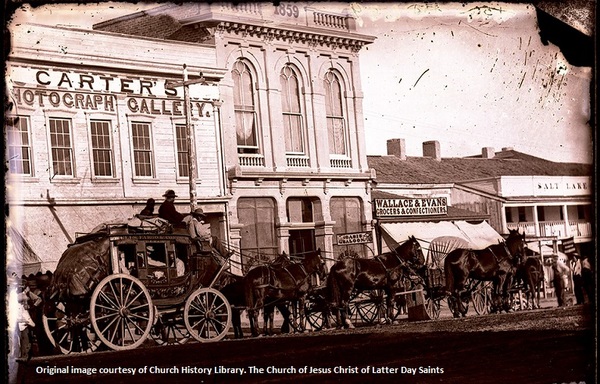Dublin Core
Title
Description
The stagecoach is a legendary symbol of the American West, part of a transportation network that spanned the continent. How did Utah fit into this network?
Traveling to Utah was difficult – to say the least – in the mid-19th Century. Major land routes between the east and west coasts skirted Utah to the north and south. The need for easier communication between a quickly growing Salt Lake City and the outside world drove the development of new transportation routes for both mail and passengers.
The first such stagecoach service to meet the demand was started in 1858 by George Chorpenning using the Central Overland Route, a new trail that ran through central Utah and Nevada to California. The route was originally scouted in 1855 by Howard Egan, who used it to drive cattle, and was improved by US Army Captain James Simpson, who used it to supply Camp Floyd during the Utah War. The new route was about 280 miles shorter than the more northerly California Trail, shaving off two weeks of travel.
The outbreak of the Civil War in 1861 blocked stagecoach transportation in the south, forcing the US Government to shift its communication lines north to the Central Overland Route. Wells Fargo purchased the route and their iconic stagecoaches ran regularly through Salt Lake City. Stages changed teams about every 13 miles, so stops developed along the way. The Stagecoach Inn – which still exists in Fairfield, Utah, across from Camp Floyd – was one of these stops.
Passengers could now travel from Missouri to California in about 25 days. In 1863, the fare was $200 and meals were 60 cents. Many famous people traveled the route through Utah, including writer Mark Twain, newspaper editor Horace Greeley, and English explorer Richard Burton. Burton described the torture along some parts of the route, saying that passengers became “crazy by whisky, mixed with want of sleep.”
With the completion of the Transcontinental Railroad in 1869, the Central Overland Route through Utah was practically abandoned. Although stagecoaches continued to reach areas not served by the railroad, the heyday of the stagecoach was over.
Creator
Michelle Hill for Utah Humanities © 2015
Source
See Ouida Blanthorn, A History of Tooele County, (Salt Lake City: Utah State Historical Society, 1998), pp 108-110; Philip L. Fradkin, Stagecoach: Wells Fargo and the American West, (New York: Simon and Schuster, 2002), pp 30-31; J. Roderic, Korns, ed., “The Journal of Heinrich Lienhard,” Utah Historical Quarterly, Vol. 19, 1951, pp 108-176; W. Turrentine Jackson, “Salt Lake City: Wells Fargo’s Transportation Depot During the Stagecoach Era,” Utah Historical Quarterly, Vol. 53, No. 1, Winter 1985, pp 5-39; A. R. Mortensen, “A Pioneer Paper Mirrors the Breakup of Isolation in the Great Basin,” Utah Historical Quarterly, Vol. 20, 1952, pp 77-108; Raymond W. Settle, “The Pony Express Heroic Effort—Tragic End,” Utah Historical Quarterly, Vol. 27, No. 2, April 1959, pp 103-126. Richard Burton, The City of the Saints, (New York: Harper and Brothers, 1862); and Table of distances of the overland daily stage line, from Atchison, Kansas, to Great Salt Lake City, (New York: Slote and Janes, 1863), p 3.
Publisher
The Beehive Archive is a production of Utah Humanities. Find sources and the whole collection of past episodes at www.utahhumanities.org
Date
2015-02-06

